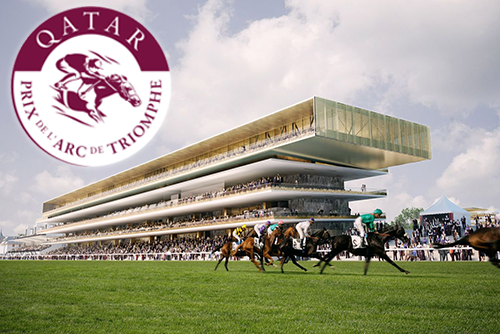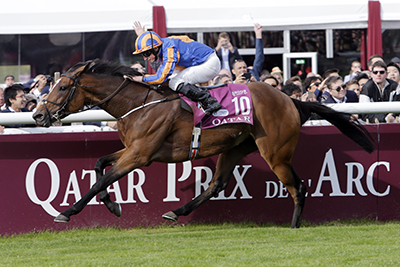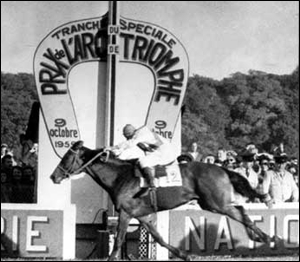
Prix de l’Arc de Triomphe Betting Guide
 If you’re a casual follower of horse racing, you might be surprised to learn that there are many other races across the world that rival North America’s Kentucky Derby, Preakness Stakes, and Belmont Stakes in popularity and prestige.
If you’re a casual follower of horse racing, you might be surprised to learn that there are many other races across the world that rival North America’s Kentucky Derby, Preakness Stakes, and Belmont Stakes in popularity and prestige.
The Prix de l’Arc de Triomphe is certainly one of them. Nearly a century old, the Arc is Europe’s richest horse race, ranking behind only the Pegasus World Cup and Dubai World Cup when it comes to total prize purse up for grabs. At approximately 1.5 miles long (2,400 meters, to be exact), the Prix de l’Arc de Triomphe is open to all Thoroughbreds aged three years or older, regularly drawing an impressive field of past and current champions from other events.
In this betting guide, we’ll cover everything you need to know about betting on France’s classic horse racing spectacle.
When Is the Prix de l’Arc de Triomphe?
The Prix de l’Arc de Triomphe is held each fall in Paris, typically on the first Sunday in October but occasionally in late September. The 2018 race is slated for October 7, and post time is expected to be at approximately 10 a.m. Eastern time (4 p.m. locally). The 2017 Prix de l’Arc de Triomphe was broadcast in 50 countries, while more than 1 billion people across the world were expected to tune in.
ParisLongchamp Racecourse is the long-time home of the Prix de l’Arc de Triomphe, but the 2016 and 2017 races were contested at nearby Chantilly Racecourse while Longchamp underwent renovations. Now that the refurbishment is complete, Longchamp will be home to the race once again going forward.
Best Sites to Bet the Prix de l’Arc de Triomphe
When an event is as popular as the Prix de l’Arc de Triomphe, virtually every betting site online is going to offer wagering on it. However, certain sites are better choices than others for betting on the Arc.
Before you join a betting site and make a deposit to bet on the Prix de l’Arc de Triomphe, it’s important to know for certain that your money is safe. After all, if the site you are joining doesn’t have a rock-solid history of paying out winners, you’re better off making a wager with your friends. At least that way, you’ll know that someone’s getting paid.
The good news is that many sites out there have strong reputations in that department. Here are the top ones that we recommend, based on our years of experience in the online betting industry:
| RANK | GAMBLING SITE | BONUS | PRODUCT OFFERS | REVIEW | VISIT |
|---|---|---|---|---|---|
| 1 |  |
€30 | 



|
READ REVIEW | VISIT SITE |
| 2 |  |
€200 | 



|
READ REVIEW | VISIT SITE |
| 3 |  |
Get €30 | 



|
READ REVIEW | VISIT SITE |
Previous Prix de l’Arc de Triomphe Winners
Unlike notable North American races like the Kentucky Derby, Preakness Stakes, and Belmont Stakes, the Prix de l’Arc de Triomphe does not have a maximum age limit for its participants. That means that champion horses have a chance to defend their title the following year.
Six horses have done that successfully in the history of the Prix de l’Arc de Triomphe, although only one (Treve, 2013-14) has won back-to-back races over the past 40 years. Motrico is the other two-time champion of the Prix de l’Arc de Triomphe, but his titles came two years apart (1930 and 1932).
Here’s a full rundown of the year-by-year winners of the Prix de l’Arc de Triomphe (multi-time winners are noted with an *):
- 2017: Enable
- 2016: Found
- 2015: Golden Horn
- 2014: Treve*
- 2013: Treve*
- 2012: Solemia
- 2011: Danedream
- 2010: Workforce
- 2009: Sea the Stars
- 2008: Zarkava
- 2007: Dylan Thomas
- 2006: Rail Link
- 2005: Hurricane Run
- 2004: Bago
- 2003: Dalakhani
- 2002: Marienbard
- 2001: Sakhee
- 2000: Sinndar
- 1999: Montjeu
- 1998: Sagamix
- 1997: Peintre Celebre
Track Info
The track at Longchamps Racecourse is made of grass, making the Prix de l’Arc de Triomphe the world’s richest horse race on turf.
Although the recent renovations at the track included improvements to the weighing room, parade ring, and grandstands, the racing surface itself has remained relatively unchanged. One notable improvement to the track, however, is a superior irrigation system that officials hope will result in a more uniform surface from start to finish.
Longchamps remains unique because of how its four different courses are linked together, enabling it to accommodate races ranging from 1,000 to 4,000 meters in length.
Prix de l’Arc de Triomphe Records
While many of the most historic and prestigious horse races in the world have long-standing records that may never be broken, several standards in the Prix de l’Arc de Triomphe have been set in recent years. In fact, some of the record holders are still active today, leading to the possibility that they may improve on those records once again in the near future.
Fastest Time
 Irish Thoroughbred Found is technically the record holder for the fastest time ever posted at the Prix de l’Arc de Triomphe, but her 2016 mark does come with a bit of an asterisk. Found’s time of 2:23.61 was nearly a full second ahead of any other winner in the history of the event, but the 2016 race was held at a different track (Chantilly, which hosted the race from 2016-17 while Longchamp was being renovated) than where the rest of those top times were recorded.
Irish Thoroughbred Found is technically the record holder for the fastest time ever posted at the Prix de l’Arc de Triomphe, but her 2016 mark does come with a bit of an asterisk. Found’s time of 2:23.61 was nearly a full second ahead of any other winner in the history of the event, but the 2016 race was held at a different track (Chantilly, which hosted the race from 2016-17 while Longchamp was being renovated) than where the rest of those top times were recorded.
Danedream owns the record for the fastest winning time at Longchamp, crossing the line in a time of 2:24.49 in 2011. Interestingly, the 14 fastest times in Prix de l’Arc de Triomphe history have all been posted since 1987, suggesting either the horses have gotten faster in recent years or the track has become more favorable.
Biggest Winning Margin
Although the Prix de l’Arc de Triomphe is one of the longest Thoroughbred sprinting races in the world, no horse has dominated the rest of the field as much as we’ve seen in other notable lengthy competitions.
The largest winning margin in the history of the Prix de l’Arc de Triomphe is a mere six lengths, a margin of victory that has been accomplished three times (Ribot in 1956, Sea Bird in 1965, and Sakhee in 2001). By comparison, Secretariat won the 1973 Belmont Stakes (a race that is approximately the same distance as the Prix de l’Arc) by an astounding 31 lengths, and two other horses have won the Belmont by at least 20 lengths.
Biggest Field
Thanks to its prestige, large prize purse, and late-season scheduling, the Prix de l’Arc de Triomphe regularly attracts large fields. The biggest in the history of the event came in 1967, when 30 horses competed in the race.
With all of that congestion on the track, it’s no wonder that Topyo’s winning time of 2:38.20 was only a few seconds ahead of the worst winning times in Prix de l’Arc de Triomphe history.
Smallest Field
The all-time smallest field to compete in the Prix de l’Arc de Triomphe was a seven-horse competition in 1941. It’s no coincidence that the smallest field in event history came directly after the Prix de l’Arc was canceled in back-to-back years due to World War II.
The race’s popularity immediately grew once again after that, featuring no less than nine horses until an eight-horse field participated in the 2006 competition.
Winner with the Highest Odds
It’s difficult to find a complete list of odds for every winning horse in Prix de l’Arc de Triomphe history, but it’s hard to imagine that any champion ever paid more handsomely than Star Appeal did in 1975.
Racing in a 24-horse field highlighted by 1975 Arc champion Allez France and multiple Group-One winner Dahlia, Star Appeal paid a whopping 119:1 odds at post time. But Allez France and Dahlia both ran into trouble near the midpoint of the tightly-bunched race, opening the window for Star Appeal to burst through down the stretch and eventually prevail by three lengths.
The five-year-old was the first German-trained Thoroughbred to win the Prix de l’Arc de Triomphe.
Most Successful Trainers
 Legendary French trainer Andre Fabre has produced the most champions in the history of the Prix de l’Arc de Triomphe, sending seven horses to the winner’s circle.
Legendary French trainer Andre Fabre has produced the most champions in the history of the Prix de l’Arc de Triomphe, sending seven horses to the winner’s circle.
Though Fabre is now in his 70s, he still continues to work as a trainer, looking to add to an already-brilliant resume that includes being named his country’s top trainer 21 straight years from 1987-2007. Fabre’s last winner at the Prix de l’Arc de Triomphe, however, dates back to Rail Link in 2006.
Most Successful Jockeys
Italy’s Frankie Dettori is one of the most decorated jockeys in the world, and he’s done a lot of his damage at the Prix de l’Arc de Triomphe.
Dettori won his fifth career Arc title in 2017 aboard odds-on favorite Enable, two years after denying Treve a three-peat when he rode Golden Horn to victory in 2015. He was also a back-to-back champion in 2001-2002 aboard Sakhee and Marienbard, respectively.
Thierry Jarnet is one of several jockeys to post four victories at the Prix de l’Arc de Triomphe and the only one who is still active, giving him a chance of tying or eventually overtaking Dettori for the all-time lead in Arc wins by a jockey. Jarnet led Treve to back-to-back victories in 2013-14.
History of the Prix de l’Arc de Triomphe
 When the Prix de l’Arc de Triomphe was first founded in 1920, it was simply a complement to the already-existing Prix du Conseil Municipal, an international race for top horses of various age groups. Unlike the Prix du Conseil, however, the Prix de l’Arc did not use a weighting system based on each horse’s previous performances, instead allowing horses to compete on equal terms.
When the Prix de l’Arc de Triomphe was first founded in 1920, it was simply a complement to the already-existing Prix du Conseil Municipal, an international race for top horses of various age groups. Unlike the Prix du Conseil, however, the Prix de l’Arc did not use a weighting system based on each horse’s previous performances, instead allowing horses to compete on equal terms.
The race is named after the Arc de Triomphe, a famous monument in Paris that was inaugurated in 1836 by King Louis-Philippe and dedicated to the armies of the Revolution and the Empire. The Arc had added significance in 1920 following the conclusion of World War I, having served as the scene for a victory parade by the Allies. One of the race’s famous slogans cleverly refers to its ties to the Arc de Triomphe, declaring that the event is “not a race, it’s a monument.”
France’s government supported the event in its early years, first offering state funding in 1936 by way of a lottery that awarded cash prizes to both the participants and fans. By 1950, the jackpot for the race had increased to 50 million francs, drawing entrants from all over the world as well as crowds of 150,000 people. Though government and lottery funding ended in 1982, the Prix de l’Arc de Triomphe has maintained its rich purse (third-largest in the world) through sponsorships secured by the event’s massive notoriety and international appeal.
There have been many great races and dramatic finishes at the Prix de l’Arc de Triomphe over the years, but the 1986 event stands out as arguably the greatest in the Arc’s history. The 15-horse field that year featured eight runners who had won major titles earlier in the season, and favorite Dancing Brave needed a then-record time of 2:27.7 to prevail by 1.5 lengths over second-place Bering.
North American horse racing bettors don’t have to limit themselves to the Triple Crown events. There are several other significant races that deserve your wagering attention as well, particularly the Prix de l’Arc de Triomphe.
The event’s large prize purse and long-time prestige attracts the top horses from across the world, and those massive fields mean that even the favorites typically pay a nice return. It’s also nice to be able to bet on a race in which we’ve seen the horses compete in the past (remember, there’s no age limit at the Arc, so horses can enter in consecutive years), making it easier to handicap the field.
If you haven’t bet on the Prix de l’Arc de Triomphe before, 2025 is the perfect time to start! The event’s return to Longchamps will be accompanied by an extra buzz in the air, making for an exciting betting experience regardless of the outcome.